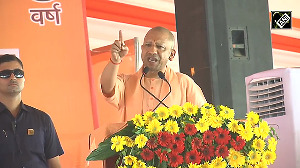It is easy to invest in exotic products, but difficult to exit them.
Think carefully before investing rather than being blown away by expected returns alone, suggests Mrin Agarwal, founder, Finsafe India.
Illustration: Dominic Xavier/Rediff.com

Most ultra-high net worth individuals' (UHNI) portfolios usually contain alternative investment products like market-linked debentures, real estate funds, private equity (PE) funds, and so on.
Wealth management firms sell these products to investors, marketing them as exotic instruments that are available only to a select few.
They also tell investors that these alternative products have the potential to give higher returns and will help in portfolio diversification.
High net worth individuals (HNIs) get swayed, especially when they see other wealthy investors putting their money in such instruments.
The exclusiveness of the products gives them a high, making them believe they are smarter and more evolved investors.
Understand the risks
Most investors, however, enter these products without understanding the risks in them fully.
Take market-linked debentures or equity-linked debentures (MLD/ELD) as an example.
These are structured investments, where a non-convertible debenture is issued, and returns are linked to equity markets.
These products use terms like participation rate, knockout level, payout ratio, etc which most people do not understand.
Investors also think ELDs are instruments that protect capital and can offer returns between 12% and 17% a year.
To them, structured products look better than mutual funds, which don't guarantee capital protection or returns.
But they fail to consider the risks involved.
When investing, one needs to understand the end use of the money.
Non-banking financial companies (NBFCs) issue ELDs.
The funds are used to give loan against shares, margin financing, and structured lending.
Essentially, the investor lends money to an NBFC to use it for its lending activities.
Such investments have many risks.
First, there is concentration risk because the investor is exposing a large amount of her/his capital to one NBFC.
Individual investors have no way of assessing the credit worthiness of an NBFC.
Recent instances of fixed maturity plans (FMPs) defaulting on repayment show that at an institutional level, too, risk management is a challenge.
At the individual investor's level, it is nearly impossible.
There is no liquidity in these products, and in a few cases, the cost of unwinding them is as high as 2%.
Alternative investments have higher costs
ELDs have a participation rate, which is the ratio of appreciation.
So, if the index appreciates by 10% and the participation rate is 60%, then the investor will get 6%.
But if one believes that the markets would gain over the next few years, then why restrict participation?
One can easily invest in a combination of large-cap funds with short-term plans and achieve capital protection (principle remaining the same), as well as earn market-linked returns.
And one can do so without paying high costs.
ELDs's fees can range from 3% to 5%.
Since it is inbuilt, investors believe they are no-cost products.
Most alternative investment products like PE funds or real estate funds have fixed and performance-linked fees.
While investors understand fixed management fees, they don't take into account performance fees, which can have an impact of 4-6 per cent on overall return.
Keep an investment checklist
Investors are taken in by the exclusivity and supposedly high returns associated with alternative investments.
When investing in any product, use the following checklist.
Calculate risk-adjusted return:
Ask yourself if the returns are commensurate with the risks being taken.
One of the largest real estate funds had an internal rate of return (XIRR) of 8% post expenses and post-tax over an extended period.
Investors can make such returns with lesser risk in a short-term debt funds.
For the risk an investor takes in real estate or private equity fund, the net return should be at least 5 percentage points higher than what could be made in an equity fund.
It is, therefore, not only essential to evaluate a product on net returns, but one also needs to check the amount of risk involved in generating them.
Check end-use of the fund:
If you do not understand where your money is being invested, stay away.
Over the past few years, HNIs have invested in start-ups, mostly because people in their peer group were doing so.
Most of these investors do not have the expertise or time to analyse balance sheets or conduct due diligence on the company they are investing in.
What works for others may not work for you, and it is crucial to figure out what risk level is suitable for you.
Costs and taxation:
Investors often do not differentiate between gross return and net return.
They do not factor in performance fees and taxes while calculating returns.
Costs that are built-in -- they are deducted from your returns and not charged separately - can have a considerable impact on returns.
The calculation of performance fee is also essential.
Check if it's with catch-up.
Catch-up refers to a situation in which a manager is fully compensated at the agreed-upon rate once investors receive their expected returns.
Under such an arrangement, investors may receive profit in addition to their expected return once the manager has received his cut.
Most investors find catch-up difficult to fathom.
Further, investors do not understand the concept of pass-through for taxation.
Product liquidity:
Is premature exit allowed, and if so, is it easy to exit the product? Can it be sold on an exchange, or does one need to find a buyer for it through a financial institution? The latter option can be a cumbersome, time consuming and expensive.
There can also be premature closure charges.
If a product has a lock-in, it should ideally generate extra returns.
There should be a trade-off for locking in money.
Portfolio diversification:
If one has a portfolio which is skewed towards equities, adding an ELD or a PE fund will increase equity allocation, and not debt allocation.
Clients must also keep a watch on the concentration level of their overall portfolio towards a particular index.
Having too many ELDs, for instance, could mean a high exposure to a specific index.
It is easy to invest in exotic products but difficult to exit them.
Think carefully before investing rather than being blown away by expected returns alone.
Whether someone is an HNI or a retail investor, it's always better to invest in simple instruments.











 © 2025
© 2025